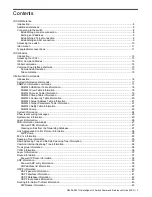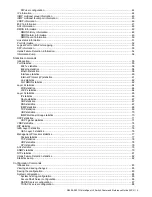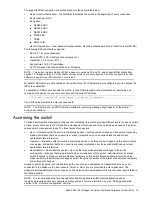
N8406-023 1Gb Intelligent L3 Switch Command Reference Guide (ISCLI) 11
Table 2 User access levels
User account
Description and tasks performed
User
The User has no direct responsibility for switch management. He or she can view all switch
status information and statistics, but cannot make any configuration changes to the switch.
The user account is enabled by default, and the default password is
user
.
Oper
The Operator has no direct responsibility for switch management. He or she can view all
switch status information and statistics, but cannot make any configuration changes to the
switch.
By default, the operator account is disabled and has no password.
Admin
The super user administrator has complete access to all command modes on the switch,
including the ability to change both the user and administrator passwords.
The admin account is enabled by default, and the default password is
admin
.
NOTE: With the exception of the admin user, access to each user level can be disabled by setting the
password to an empty value.
Once you enter the administrator password and it is verified, you are given complete access to this switch.
Idle timeout
By default, this switch disconnects the console, Telnet, or SSH session after five minutes of inactivity. This function
is controlled by the idle timeout parameter, which can be set from 1 to 60 minutes. To change this parameter, see
the ―System configuration‖ section in the ―Configuration Commands‖ chapter.
Typographical conventions
The following table describes the typographic styles used in this guide:
Typeface or symbol
Meaning
angle brackets < >
Indicate a variable to enter based on the description inside the brackets. Do not type the
brackets as you enter the command.
Example: If the command syntax is
ping <
IP address
>
you enter
ping 192.32.10.12
bold body text
Indicates objects, such as window names, icons, and user-interface objects, such as
buttons and tabs.
bold Courier text
Indicates command names, options, and text that you must enter.
Example:
Use the
show ip arp
commands.
plain Courier text
Indicates command syntax and system output (for example: prompts and system
messages). Example:
configure terminal
braces { }
Indicate required elements in syntax descriptions where there is more than one option.
You must choose only one of the options. Do not type the braces when entering the
command.
Example: If the command syntax is
show portchannel {<
1-12
>|hash|information}
you must enter:
show portchannel <
1-12
>
or
show portchannel hash
or
show portchannel information












































